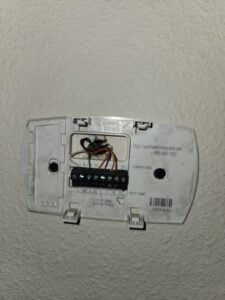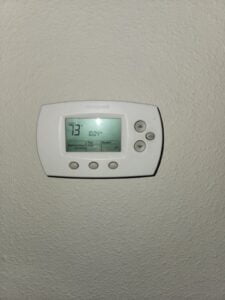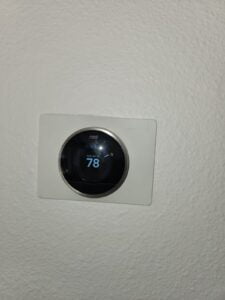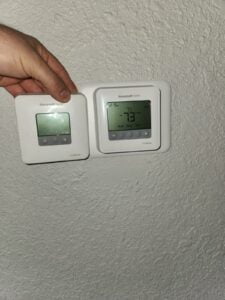6 Common Thermostat Problems and How to Fix Them
In the modern home, a thermostat is essential for maintaining comfort. However, like any piece of technology, it can encounter problems. Understanding these issues and how to fix them can save you time and money and ensure your home remains at the ideal temperature. This comprehensive guide will delve into common thermostat problems and provide step-by-step solutions.
Understanding Your Thermostat
Before diving into troubleshooting, it’s crucial to understand the types of thermostats and how they work. There are primarily two types: mechanical (analog) and digital. Mechanical thermostats use bi-metallic strips or gas-filled bellows to gauge temperature, while digital ones use sensors and are often programmable.


Common Thermostat Problems and Solutions
1. Thermostat Does Not Turn On
When your thermostat does not turn on, it can be a source of concern, especially during extreme weather conditions. Here are some steps you can take to troubleshoot and potentially resolve the issue:
When your thermostat does not turn on, it can be a source of concern, especially during extreme weather conditions. Here are some steps you can take to troubleshoot and potentially resolve the issue:
- Check the Power Source:
- Batteries: If your thermostat is battery-operated, the first step is to replace the batteries. Even if the display is still visible, low batteries can prevent the thermostat from operating correctly.
- Circuit Breaker: For thermostats connected to your home’s electrical system, check your circuit breaker or fuse box. A tripped breaker or blown fuse can cut power to the thermostat. Reset the breaker or replace the fuse if necessary.
- Inspect the Wiring:
- If you’re comfortable with it, remove the thermostat cover and check the wiring. Look for any loose connections or signs of corrosion. Tighten any loose connections and clean any corrosion you find. Be sure to turn off the power to the thermostat at the breaker box before touching any wires.
- Check the Furnace Switch and Panel:
- Many HVAC systems have a switch on the furnace itself that controls power to the system. Ensure this switch is in the “on” position. Also, check if the furnace door is properly closed. Some systems have a safety switch that cuts power to the thermostat if the furnace door is open.
- Thermostat Reset:
- Some digital thermostats have a reset button or a specific procedure to reset them. Consult the thermostat’s manual for instructions on how to reset it.
- Check for Tripped Safety Switches:
- HVAC systems often have safety switches that can trip and cut power to the thermostat. These can be triggered by things like clogged filters or drainage issues. Check for any such issues and address them.
- Thermostat Age:
- If your thermostat is old, it might have reached the end of its life. In this case, replacing the thermostat could be the best solution.
- HVAC System Issues:
- Sometimes the problem is not with the thermostat itself but with the HVAC system. Issues like a blown transformer, a tripped limit switch, or other HVAC-specific problems can prevent the thermostat from turning on.
2. Inaccurate Temperature Readings
When dealing with a thermostat problem, one of the most common issues homeowners encounter is inaccurate temperature readings. This particular thermostat problem can lead to discomfort in your home and increased energy bills. Understanding how to troubleshoot this thermostat problem is essential for maintaining a comfortable and efficient living environment.
Identifying the Thermostat Problem: Inaccurate Temperature Readings
The first step in addressing this thermostat problem is to confirm that the thermostat is indeed giving inaccurate readings. Compare the temperature reading on the thermostat with a separate room thermometer. If there’s a significant discrepancy, you’ve pinpointed a thermostat problem.
Common Causes of This Thermostat Problem
Several factors can contribute to this thermostat problem, and identifying the root cause is crucial for resolution:
- Improper Thermostat Placement: If your thermostat is placed in a location where it’s exposed to direct sunlight, drafts, or heat sources (like kitchen appliances), it can give false readings. This thermostat problem is often overlooked.
- Dirt and Dust Accumulation: A common thermostat problem is the buildup of dust and dirt inside the thermostat. This can interfere with its ability to accurately read the room’s temperature.
- Aging or Faulty Sensor: Over time, the sensor within the thermostat can wear out or malfunction, leading to this thermostat problem. An aging thermostat is more prone to such issues.
- Thermostat Calibration Issues: Sometimes, the thermostat problem stems from a need for recalibration. This is especially true for older, analog thermostats.
Solving the Thermostat Problem
To effectively solve this thermostat problem, follow these steps:
- Relocate the Thermostat: If the thermostat problem is due to its location, move it to a more suitable spot. It should be away from direct sunlight, drafts, and heat sources.
- Clean the Thermostat: Address the thermostat problem of dirt accumulation by carefully cleaning the interior of the thermostat. Turn off the power to the thermostat, remove the cover, and gently clean the components.
- Recalibrate or Replace the Sensor: For calibration-related thermostat problems, consult the manual for instructions on recalibrating your model. If the sensor is faulty, consider replacing the thermostat.
- Upgrade Your Thermostat: If the thermostat problem persists despite troubleshooting, it might be time to upgrade to a newer, more accurate model. Modern digital or smart thermostats offer improved accuracy and efficiency.
3. The HVAC System Doesn’t Respond to Thermostat Settings
When your HVAC system doesn’t respond to thermostat settings, it’s a common and frustrating thermostat problem that requires prompt attention. This thermostat problem can stem from various sources, ranging from simple issues like incorrect settings to more complex problems involving wiring or HVAC equipment malfunctions. Here’s how to troubleshoot and potentially resolve this thermostat problem:
- Check Thermostat Settings: The first step in addressing this thermostat problem is to ensure that the thermostat is set correctly. Verify that it’s switched to the appropriate mode (heating or cooling) and that the set temperature is different from the current room temperature.
- Power Issues: A basic but often overlooked aspect of this thermostat problem is checking if the thermostat and the HVAC system have power. Ensure the thermostat’s batteries are functioning if it’s battery-operated. For wired models, check your home’s electrical panel for any tripped breakers or blown fuses.
- Inspect Wiring Connections: Faulty or loose wiring can lead to this thermostat problem. Carefully inspect the wiring connections at the thermostat and the HVAC unit. Make sure all connections are secure and there is no visible damage to the wires. Remember to turn off the power before handling any wires.
- Thermostat Calibration: Incorrect calibration can cause this thermostat problem. Some thermostats allow for recalibration, which can be done following the manufacturer’s instructions. This is particularly relevant for older, analog thermostats.
- HVAC System Check: Sometimes, the thermostat problem lies not with the thermostat itself but with the HVAC system. Check for any visible signs of malfunction in your HVAC system, such as strange noises, leaks, or failure to start.
- Air Filter Inspection: A clogged air filter can lead to various HVAC issues, including this thermostat problem. Ensure that the air filter is clean and replace it if it’s dirty. A clean filter allows for proper airflow, which is crucial for the system’s operation.
- Thermostat Age and Functionality: If your thermostat is old or has been problematic, it might be the root of this thermostat problem. Older thermostats can lose their efficiency and might need to be replaced.
- System Compatibility: Ensure that your thermostat is compatible with your HVAC system. Incompatibility can lead to thermostat problems, including a lack of response from the HVAC system.
- Reset the Thermostat: Sometimes, simply resetting the thermostat can resolve the thermostat problem. Refer to the user manual for the correct reset procedure for your specific model.
4. Thermostat Loses Programmable Settings
When a thermostat loses its programmable settings, it’s a common thermostat problem that can disrupt your home’s heating and cooling schedule. This thermostat problem can be caused by various factors, ranging from power issues to internal malfunctions. Here are some steps to troubleshoot and resolve this thermostat problem:
- Check the Power Source:
- A frequent cause of this thermostat problem is power loss. If your thermostat operates on batteries, replace them to see if this resolves the issue. For wired thermostats, ensure there are no issues with the home’s electrical supply, such as tripped circuit breakers or blown fuses.
- Inspect for Loose Wiring:
- This thermostat problem can sometimes be due to loose or corroded wiring connections. Carefully inspect the wiring, ensuring all connections are tight and secure. Remember to turn off the power to the thermostat before handling any wires.
- Internal Memory or Circuitry Issues:
- If the thermostat frequently loses its settings, it could indicate an issue with the internal memory or circuitry. This type of thermostat problem may require professional diagnosis and potential replacement of the thermostat.
- Factory Reset:
- Performing a factory reset can sometimes resolve this thermostat problem. This process will return the thermostat to its original settings, so you will need to reprogram it. Consult the thermostat’s manual for instructions on how to perform a reset.
- Firmware Updates for Smart Thermostats:
- If you have a smart thermostat, this problem could be due to outdated firmware. Check for any available updates and install them, as they can often fix bugs and improve functionality.
- Voltage Fluctuations or Power Surges:
- Voltage fluctuations or power surges in your home can lead to this thermostat problem. Using a surge protector can help protect the thermostat from such issues.
- Thermostat Age:
- Older thermostats may start to experience this problem more frequently as they age. If your thermostat is old and continues to lose its settings, consider upgrading to a newer model.
- Interference with Wireless Thermostats:
- For wireless or Wi-Fi-enabled thermostats, interference from other wireless devices can sometimes cause this problem. Ensure your thermostat is positioned away from potential sources of interference.
- Consult the User Manual:
- The thermostat’s user manual may have specific troubleshooting tips for this problem. It can provide model-specific instructions that are more tailored to your device.
5. Thermostat Causes Short Cycling
Short cycling, where your HVAC system turns on and off more frequently than normal, is a significant thermostat problem that can lead to increased wear and tear on your system, discomfort in your home, and higher energy bills. This thermostat problem can be caused by various issues, some related directly to the thermostat and others to the broader HVAC system. Here’s how to troubleshoot and address the thermostat problem of short cycling:
- Incorrect Thermostat Placement:
- One common cause of this thermostat problem is the placement of the thermostat. If it’s located near drafts, in direct sunlight, near windows or doors, or close to heat sources, it can misread the actual room temperature, leading to short cycling. Relocating the thermostat to a more neutral location can resolve this issue.
- Thermostat Calibration:
- A miscalibrated thermostat can also cause short cycling. This thermostat problem can often be resolved by recalibrating the thermostat. Check your thermostat’s manual for instructions on how to recalibrate it.
- Faulty Thermostat Sensor:
- A malfunctioning thermostat sensor is another potential cause of this thermostat problem. If the sensor is not working correctly, it may incorrectly read the temperature, causing the system to cycle on and off improperly. In such cases, the thermostat may need to be repaired or replaced.
- Heat Anticipator Adjustment:
- If you have a mechanical thermostat, it might have a heat anticipator. If this is set incorrectly, it can lead to short cycling. Adjusting the heat anticipator can help resolve this thermostat problem. Refer to the thermostat’s manual for guidance on adjusting it.
- Check HVAC System:
- Sometimes the thermostat problem of short cycling is a symptom of a larger issue with the HVAC system. Problems like an oversized system, a clogged air filter, or malfunctioning components can cause short cycling. Regular maintenance of your HVAC system can help prevent these issues.
- Electrical Issues:
- Electrical problems, either in the thermostat itself or in the HVAC system, can lead to short cycling. Inspect for loose connections or signs of wear in the wiring. If you’re not comfortable doing this, it’s best to call a professional.
- Thermostat Type:
- Some older thermostats or non-programmable models may not efficiently regulate newer HVAC systems, leading to short cycling. Upgrading to a programmable or smart thermostat can often resolve this thermostat problem.
6. The Thermostat Screen is Blank
A blank screen on your thermostat is a common thermostat problem that can be both confusing and concerning. This thermostat problem can arise due to various reasons, ranging from simple issues like dead batteries to more complex electrical problems. Here’s a step-by-step guide to troubleshoot this thermostat problem:
- Check the Batteries:
- If your thermostat is battery-powered, the first and simplest step to address this thermostat problem is to replace the batteries. Even if your thermostat is wired to the home’s electrical system, it may still have backup batteries that need replacing.
- Inspect the Circuit Breaker:
- A tripped circuit breaker is another common cause of this thermostat problem. Check your home’s electrical panel and reset any tripped breakers. Sometimes, a power surge can trip the breaker connected to your HVAC system and thermostat.
- Examine the Furnace Switch and Panel:
- Ensure that the furnace or air handler switch is turned on. Sometimes, this switch can be accidentally turned off, leading to the thermostat problem of a blank screen.
- Look for a Blown Fuse:
- Some HVAC systems have a fuse on the control board, which can blow and cause the thermostat to lose power. Inspect the fuse and replace it if necessary. This is a more advanced step; if you’re not comfortable doing this, it’s best to call a professional.
- Check the Wiring:
- Loose or corroded wiring can also lead to this thermostat problem. If you’re comfortable and knowledgeable, you can check the wiring connections to the thermostat for any issues. Ensure the power is off before attempting to inspect or adjust wiring.
- Consider the Age of the Thermostat:
- If your thermostat is old, it might simply have reached the end of its life, leading to this thermostat problem. In this case, replacing the thermostat may be the best solution.
- Look for Safety Switches:
- Some HVAC systems have safety switches that cut power to the thermostat if there’s a problem like a clogged condensate drain. Check if any safety switches have been triggered.
- Reset the Thermostat:
- If your thermostat has a reset button or a specific reset procedure, try this to see if it resolves the thermostat problem. Consult the user manual for instructions.
6 Common Thermostat Problems and How to Fix Them: Expert Tips from The AC Therapist
In conclusion, thermostat problems, ranging from blank screens to short cycling, can be more than just minor annoyances; they can impact the comfort and efficiency of your home. Understanding these six common issues and knowing how to address them can save you both time and discomfort. Remember, regular maintenance and a keen eye can often prevent or quickly resolve these problems. However, when a problem persists or you’re unsure about a solution, don’t hesitate to reach out to the experts. The AC Therapist is always here to help, offering professional advice and services to ensure your home’s climate control is functioning smoothly and efficiently. Trust us to be your go-to guide and solution provider for all your HVAC needs.











